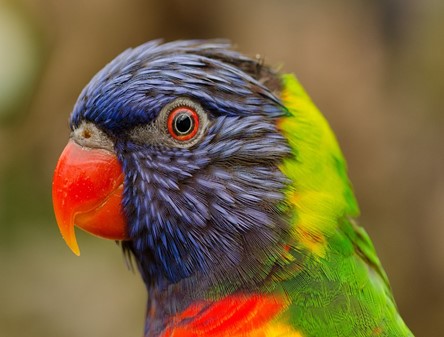CHAPTERS
Navigate to chapter
► Chapter One: Introduction
► Chapter Two: What are Lories and Lorikeets?
► Chapter Three: Lories and Lorikeets’ Requirements
► Chapter Four: Tips in Buying Lories and Lorikeets
► Chapter Five: Maintenance for Lories and Lorikeets
► Chapter Seven: Keeping Lories and Lorikeets Healthy
► Chapter Eight: Lories and Lorikeet in Summary
Chapter Two: What are Lories and Lorikeets?

These colorfully talkative birds have some are perhaps the most amiable and docile of all the parrot specie. This duo tends to warm up to people easily and is also quite the comic who likes to show off its acrobatic abilities. They are born entertainers who like to play, explore, and if given the proper training, are chatty companions who can be taught to do simple tricks. They are flock oriented avian and get on quite famously with other birds with which they can chat with and those equally sized as they.
They are a bunch of very social birds that hop from tree to tree in search of their favorite meals – nectar and pollen. These prolific talkers and like to talk a lot and are often seen and heard as part of a squawking flock when foraging for food. Always on alert for predators who would like to make them their next meal, lories and lorikeets call out warning signals to warn other birds of the flock of a predator in their midst.
Once satiated and full they make their way back to their homes and are generally quite after feeding, only making noise when a predator is sensed or spotted. When a predator is near an alarm call is made to give warning to others. Predators are kept at bay because of the danger-signal system these birds give off.
There are a number of things that need to be kept in mind by any individual wanting to take in Lories and Lorikeets and you will find more useful information to these birds in the next following chapters.
Facts about Lories and Lorikeets
There are around 55 various species of these colorfully, chatty birds and this is just in the Loriinae group of parrots! A mere 12 of these smallish, colorful, and intelligent, comics and talkers are taken in as family pets. Amongst the large family of parrots and their many sorts, Lori and Lorikeets are most sought after as pets. This is mainly because of their easy-going manner, their ability to warm up to people easily and their penchant for entertaining.
Lories and Lorikeets are quite different from other parrot species because of the specialized diet they need. Unlike the other parrot species, Lories and Lorikeets do not feed off seeds. Instead they have evolved to live on pollen and nectar and in fact cannot manage to feed on seeds like their other parrot cousins.
They possess a tongue with a unique quality which allows them to feed on these kinds of sustenance. Alternately called honey eaters, this colorful duo both have unique paint brush like tongues which they use get nectar and pollen, a staple of their diet which they harvest from flowers.
Lories and Lorikeets are deft acrobats, innately playful, and naturally curious creatures. Keepers of these sorts find the everyday activities of the birds to be captivatingly amusing and entertaining. With a little bit of time and patience, you’ll discover that Lories and Lorikeets will impress you by showing off their speaking skills, learning to talk as they mimic people around them with many possessing good vocabularies that only tend to improve with time.
In the wild, Lories and lorikeets live in large flocks. Contingent of the species, Lories and Lorikeets are by nature from the Southeast Asian archipelago and regions around Australia. In search of food, these birds will fly from island to island. The perambulate rainbow lorikeet will go to where eucalyptus flowers bloom all along the coast of Australia.
Lories and Lorikeets are able to thrive for about 7 to 10 years when out in the wild. In captivity, zoo captivity particularly, these small chatterboxes enjoy a longer lifespan compared to their cousins in the wild, and live for as long as 15 years.
It is safe to assume that the birds, living in a controlled environment, enjoy better health are free of stress they would otherwise experience if in the wild, are given medical attention, as well as regular meals of a proper and balanced diet – not to mention, a whole lot of activities that allow them to interact with and be around humans and their sort.
A healthy body is usually followed by a sharp mind. Being given all the space and exercise these actively playful flyers require, as well as frequent socialization to stimulate the mind, Lories and lorikeets in captivity can be said to live sheltered lives. Many may argue that Lories and lorikeets in captivity are deprived of living free lives in the wild. And they could have a point.
But it is also owed to zoos that those in their care is given a chance to live free from predators and from humans who may hunt them for game, money, or because they are considered agricultural pests. It’s an argument that has a fine line.
Given the privilege of witnessing this playful duo, and their other kin, in a habitat meant to mimic their natural environment, we can learn more about these special sorts of parrots whilst admiring their silky-looking, shiny and colorful appearance and get to hear them show off their dexterity for speech in person as we are entertained by their comical antics.
Lories and lorikeets have an average length of 6-15 inches, depending on the species, and they have a general weight of about 20 to 280 grams, also depending on the species as some Lories and lorikeets a tad larger or smaller than others.
Continue Reading…
Want to read the entire thing?


